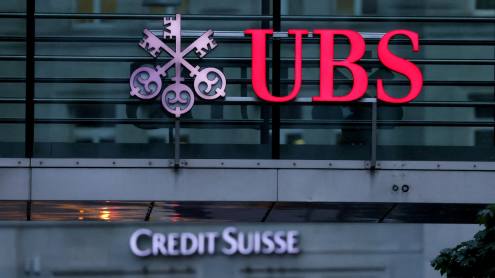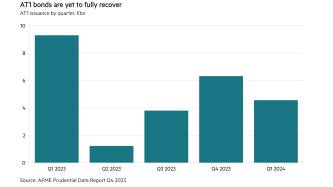The major rating agencies have already indicated that the unguaranteed ratings of most Landesbanken will be in the single A area, on a par with many other European banks (see table download). The Landesbanken have adjusted in advance to the situation by developing closer ties with their savings banks owners and by prefunding their future business (these deals will be grandfathered until end 2015 under the new law). Landesbanken will also increasingly fund using asset-backed structures and covered bonds as unsecured funding becomes more expensive.
The other new law – the replacement of the German Mortgage Bank Act with a general Covered Bond Law (Pfandbriefgesetz) – will put German bank funding on a more even keel by allowing all banks to issue covered bonds provided they meet certain criteria. Currently only mortgage and public sector banks are allowed to do this. But, again, this is unlikely to reshape German banking because large banks had previously acquired mortgage banks to enjoy this advantage.
“There will be new issuers but not a whole new wave. Some banks that own Hypothekenbanken [mortgage banks] may decide to reintegrate them back into the group,” says Robert Mandziara, a credit analyst at DZ Bank, one of the central institutions for Germany’s co-operative banks. “New issuers can’t do one issue and walk away. They have to prove they have the risk management systems and a long-term cover pool. This could be an obstacle for some of the smaller banks.” (See Covered Bonds special supplement in this issue.)
The mortgage banks themselves, however, do not necessarily regard the new legislation as a setback even though they will face increased competition.
Hubert Schulte-Kemper, chairman of the board of managing directors of the Hypothekenbank in Essen AG (Essen Hyp), says: “We expect the new regulations to enhance our room for manoeuvre and, accordingly, we are already screening the market for new business opportunities that are in line with our current strategic focus. Our further development will be supported by the expected abolition of the limitations of foreign funding activities within all EU member states, as well as the current circulation limit that restricts balance sheet growth to about 60 times liable equity.”
Lease of life
Yet, even though Germany’s banking structure appears largely unchanged, there have been some steps forward in revitalising it. Banks have started to reorganise themselves and further changes can be expected as they progress with cleaning up their balance sheets and tackle the tough problem of net interest margins that are among the world’s lowest.
German banks have to increase revenues and reduce costs. The former will be achieved by specialising and by boosting fee income as Germany’s powerful Mittelstand – the small and medium-sized companies that account for a high proportion of German output – are weaned off unprofitable loans and into the capital markets (see following article on SMEs). On the cost side, there are more staff reductions to be made along with operational changes such as locating back offices and call centres in eastern Europe.
Since the politics of many of these initiatives can be contentious, there has been a good deal of inventiveness in both the corporate and banking sectors. US funds are busy buying up non-performing loans (NPLs) from the banks and Lone Star has declared an interest in buying an entire bank (see following article on NPLs). Private equity firms are becoming increasingly active on the corporate side, too, in a market where participation by financial sponsors has been historically low. (See article on private equity in Capital Markets section.)
Also on the loan side, the launch of Deutsche Kredit Borse (DKB), a loan exchange in Munich, allows banks to offer loans to other banks to even out risk exposures. Of the 140 banks that have expressed an interest in trading loans in this way, 37 had committed to doing so as the exchange went live at the end of March (see The Banker February 2005, Vibrant innovations, pg 64). Prices are agreed bilaterally between banks and the exchange sees itself as playing a role for smaller banks that do not have the option of securitising.
New structure
The structure of German banking may look the same but even among the conservative Landesbanken there have been positive developments. A recent report by WestLB, itself a Landesbank, predicts that only three or four Landesbanken will exist in a decade’s time.
“If the Landesbanken can overcome existing political barriers, it is likely, in our view, that the number of Landesbanken in Germany will drop to four or even three over the next decade,” say the report.
Essen Hyp’s Mr Schulte-Kemper says: “Consolidation will go on. In a few years, you will start reading that bank X has bought a German savings bank. We will see the international banks moving into Germany and competition for private customers will intensify.”
In March, it was revealed that Postbank was the leading candidate to buy building society BHW and Allgemeine Hypothekenbank Rheinboden (AHBR), one of Germany’s top five mortgage banks, from BGAG, a trades union holding company.
So far among the Landesbanken, LB Baden-Württemberg has acquired LB Rheinland-Pfalz, and Landesbank Schleswig-Holstein and Hamburgische Landesbank have been merged into HSH Nordbank AG. But perhaps the greater developments are the closer agreements between Landesbanken and savings banks (Sparkassen) aimed at providing financial strength in the absence of a guarantee as well as the moves to create new revenues by specialising.
WestLB, for example, has strengthened ties with the two savings banks in its home region of North Rhine-Westphalia, Germany’s largest federal state. Mindful of the impending legal changes, in 2002 WestLB had already separated out its strictly commercial activities into a joint stock company, WestLB AG, and put its public sector activities into NRW.BANK, which is owned by the regional state authorities. Since last October, WestLB has developed a new shareholding structure with the two savings banks associations, Rheinischer Sparkassen- und Giroverband (RSGV) and Westfälisch-Lippischer Sparkassen- und Giroverband (WLSGV), each having a shareholding of 30.625%, and NRW.BANK having a shareholding of 38.75%. Reserve funds have been set up that would support member banks in times of financial crisis.
HSH Nordbank and Bayerische Landesbank have also worked out co-operation models with their savings banks. Helaba has gone even further and developed what it calls a “group concept” (Verbundkonzept), creating a binding statute between itself and the savings banks in Hesse and Thuringia.
Core activities
WestLB announced losses of €920m in March, down from €4bn in 2002 and 2003, and analysts interpreted this as a stabilisation after a long period of restructuring. WestLB is one of a number of German Landesbanken that – because of the margin constraints in their domestic business (public sector spreads are the thinnest of all) – was tempted in the past to move into higher risk activities overseas, not always with great success.
Now Landesbanken are more focused on their core activities and regions. Helaba, for example, is concentrating on real estate and HSH Nordbank on ship financing while Nord LB, Bremer LB, LBBerlin and SaarLB are focussing on their regions. DekaBank generates fee income from fund management; SachsenLB has developed expertise in structured transactions at its Dublin subsidiary; LB Baden-Wurttemberg (LBBW) has shown the benefits of vertical integration for funding purposes. Unusually for a Landesbank, LBBW has a retail franchise which was strengthened with the acquisition of Baden-Württembergische Bank that gives it an additional source of funds.
With Germany’s private commercial banks – Deutsche, Commerzbank, Dresdner and HVB – the failure to effect an in-country merger together with their weak retail position, may be considered fatal in arresting development. With 16.1% only of total banking assets, their national role is limited. Yet a closer look at their income breakdown reveals hidden strengths. While their market share of net interest income reflects their asset size – 15.9% on 2003 figures – with net commission income they punch above their weight at 33.8% and also with trading income at 76%. They have a much better diversified revenue stream, therefore, than other types of German bank.
Balancing act
Cost cutting has proceeded apace and banks have braved and negotiated their way through the political maze to bring about large declines in staff numbers. The problem is that huge redundancy costs can prevent the benefits from feeding through to the bottom line in the short term. But German banks’ stubbornly high cost/income ratios are starting to move down, with personnel cost reductions ranging from 1% to 7% and cuts in other operating expenses ranging from 3% to 21%.
Balance sheet restructuring is a many-faceted activity and there is no shortage of international investment banks proposing to advise German banks on the best course of action. Asset quality has been improved through write-offs and sales of non-performing loans while capital has been bolstered. German banks do not intend to repeat the mistake they made previously of holding capital in the form of equity holdings. During the stock market recession, depressed equity values threatened to turn “German banks’ huge hidden reserves into hidden losses large enough to put their viability at risk”, according to a report by Fitch.
The first of the four German commercial banks to bite the bullet on balance sheet cleaning was Commerzbank, followed by HVB. Both have raised fresh capital. Dresdner has focused more on reducing NPLs and disposing of non-strategic assets as illustrated by its decision to set up an Institutional Restructuring Unit (see article on NPLs).
Now considerable focus needs to be placed on the revenue side. Once again, it appears as if the period of revenue contraction may be drawing to a close and there are signs that corporate lending margins are increasing. Banks have shown themselves unwilling to continue lending at non-competitive rates and are offering customers underwriting and structuring skills instead. Investment and corporate banking are being combined to greater effect in Germany. All that needs to happen now is that German banks break the silence on their achievements.











